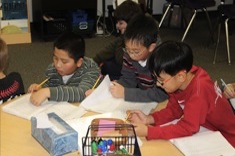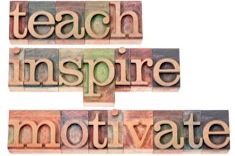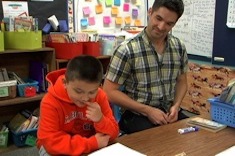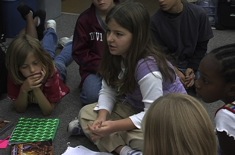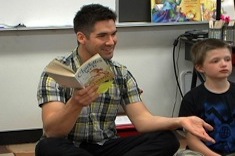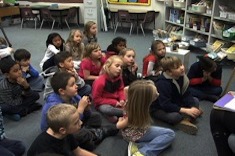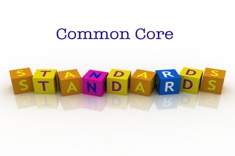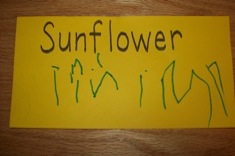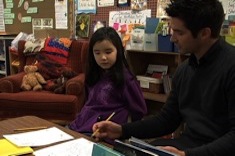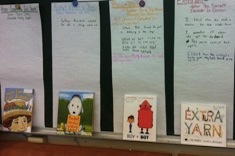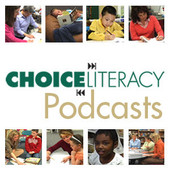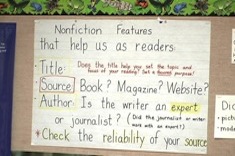Teaching Writing
Everyone who writes for Choice Literacy loves teaching writing, because we all write ourselves. We know it is "hard fun," as Donald Murray famously said—exasperating and exhilarating at the same time. The writing workshops you will read about here and see in our videos are busy, noisy, vibrant places. And most days, we wouldn't want to be anywhere else than in the midst of 'em! Here is where you'll find our latest discoveries, insights, and occasional boneheaded mistakes in teaching writing.
Latest Content
Choice and Reading Response
As more intermediate classrooms become departmentalized, grades 4-6 teachers find they are dealing with 80 or more reading response logs instead of 25-30 each week. Katherine Sokolowski tackles the issue of providing personal response to readers and still having time for everything else.
Teaching the Rule of Three to Writers
Aimee Buckner finds that teaching the rule of three to young writers adds variety to student texts.
Hearing Carlos: Helping Young English Language Learners Develop Speaking and Listening Skills
Stella Villalba incorporates more speaking and listening activities into her primary classroom for English language learners.
Writers Inspiring Writers
Melissa Styger invites colleagues and family members into the classroom to share their writing process with students.
Rethinking Mrs. T Letters
Karen Terlecky reconsiders one of her favorite writing assignments.
Second Grader Conferring: Adding Details and Descriptive Language Part 2
In this second video from a four-part series, Sean Moore confers with a student about adding details to his writing.
Peer Conferring: The “Try It On” Phase
Amanda Adrian continues her series on how teachers can scaffold and model peer conferring. In this installment, Amanda uses the fishbowl technique with students.
Second-Grade Writing: Adding Details and Descriptive Language
In this first video from a four-part series, Sean Moore leads a writing workshop focused on adding more details and descriptive language to writing. He begins with the classic Charlotte’s Web as his mentor text.
Poetry Friday in the Computer Lab
Mary Lee Hahn provides a wealth of web resources and practical suggestions for using technology for poetry instruction.
Poems Facing Art: Ekphrasis
Shirl McPhillips considers ekphrasis (poetry inspired by art) in her own poetry and reflection.
Value-Added: Moving Assessments from “Inflicted” to “Student-Owned”
Gretchen Taylor looks closely at the superficial reading responses of one student, and then uses a mid-year assessment to challenge all of her middle school readers to think, talk, and write more deeply about their reading.
Poetry All Year Long
Ann Williams shares how she builds a love of poetry in her fourth-grade classroom all year long.
Quick Sketch Practice
Linda Karamatic uses quick sketches to teach her second graders about sensory images in reading. This is the second installment in a two-part series.
Quick Sketch Sensory Images Read Aloud: Introduction
Linda Karamatic uses quick sketches to teach her second graders about sensory images in reading. This is the first installment in a two-part series.
Common Core Booklist: Writing Personal Narratives
Personal narratives are an important part of the Common Core in 4th grade. Franki Sibberson shares a booklist of some of her favorite mentor texts for teaching narratives in the intermediate grades.
Teaching Revision Through Talk, Routines, and Drawing
Clare Landrigan and Tammy Mulligan have some practical advice for using drawing, talk, and routines as ways into understanding writing revision for learners in the primary grades.
Writer’s Launch
How do preschool teachers help their young students seem themselves as writers? Leslie Woodhouse explains how she works with students early in the year, and provides many samples of starting points for three- and four-year-olds.
Informational Snapshot Writing
Heather Rader finds web video is a powerful tool for scaffolding young writers as they produce informational texts.
Mixing Information and Narratives
In this conference from a second-grade classroom, Sean Moore helps Mia flesh out her writing on friendship with examples.
Peer Conferring: The Modeling Phase
Amanda Adrian provides a framework, sample model lesson, and peer conferring guide for students to use as they learn how to respond to their classmates.
Conferring for Conventions (Conventions Series Part 5)
Heather Rader gives examples of convention conferences in this final installment of the conventions series.
Creating Anchor Charts with Multiple Classes
It’s a dilemma many middle school teachers face. How do you construct anchor charts with multiple groups of students, when only one chart will be hung in the room? Katherine Sokolowski explains how she ensures all classes have input and a “clean slate” in constructing charts.
Aligning the Common Core and Conventions Instruction (Conventions Series Part 4)
Heather Rader works with a team of intermediate teachers as they connect their plans for conventions instruction and the Common Core.
The Apple Doesn’t Fall from the Tree: Nurturing Critical Thinking and Choice with Middle School Writers
Katie Baydo-Reed has to try, try, and try again to get high quality writing and thinking from her eighth graders, but the effort builds independence and reflection.
Ten Things Every Writer Needs to Know: A Podcast with Jeff Anderson
Jeff Anderson shares some insights from his latest book in this new podcast hosted by Franki Sibberson.
Make a Really BIG List
Big lists can be intimidating, especially when our to-do lists are long and never quite finished. Ruth Ayres explains the power of big lists in other contexts, especially writing, and how they might actually provide comfort and security when tackling big projects and ideas.
Ten Classic Ideas That Still Work
Teachers are always on the hunt for something new, even as we cherish what works well year after year. Franki Sibberson lists the activities that have stood the test of time in her classroom.
Between Inquiry and Instruction (Conventions Series Part 3)
Heather Rader works with a team of intermediate teachers as they pore over student work together and analyze which conventions should be taught.
What Anchor Charts Are Essential?
Katherine Sokolowski considers what anchor charts are essential in her fifth-grade classroom, and where they work best for posting.
What Matters? Teaching Conventions Series
Heather Rader works with a team of intermediate teachers to ferret out what does and doesn’t work, based on research and experience.
Browse Content By
Type
Category
- Assessment Tools
- Big Fresh Archives
- Booklists
- Choice Numeracy
- Classroom Design
- Common Core
- Community Building
- Conferring
- Content Literacy
- Digital Literacy
- English Language Learners
- Equity
- Family Relations
- Free Samples
- Guiding Groups
- Leadership
- Literacy Coaches
- Mentor Texts
- Minilessons
- New Teacher Mentors
- Podcasts
- Poetry
- Quote Collections
- Reading Strategies
- Self Care
- Struggling and Striving Learners
- Talking and Listening
- Teacher Study Groups
- Teaching Reading
- Teaching Writing
- Word Study and Vocabulary
Author
- Melissa Quimby
- Nawal Qarooni
- Gwen Blumberg
- Julie Cox
- The Lead Learners
- Hannah Tills
- Josie Stewart
- Ruth Metcalfe
- Mallory Messenger
- Becca Burk
- Jodie Bailey
- Vivian Chen
- Mary Brower
- Tiffany Abbott Fuller
- Stephanie Affinito
- Ruth Ayres
- Leigh Anne Eck
- Heather Fisher
- Shari Frost
- Julie Johnson
- Suzy Kaback
- Gigi McAllister
- Shirl McPhillips
- Melanie Meehan
- Cathy Mere
- Debbie Miller
- Tara Barnett and Kate Mills
- Tammy Mulligan
- Dana Murphy
- Bitsy Parks
- David Pittman
- Brenda Power
- Heather Rader
- Matt Renwick
- Mandy Robek
- Christy Rush-Levine
- Gretchen Schroeder
- Jen Schwanke
- Brian Sepe
- Katherine Sokolowski
- Stella Villalba
- Jennifer Vincent
Grade Level
Choice Literacy Membership
Articles
Get full access to all Choice Literacy article content
Videos
Get full access to all Choice Literacy video content
Courses
Access Choice Literacy course curriculum and training

